Plantar Warts: causes and methods of removal
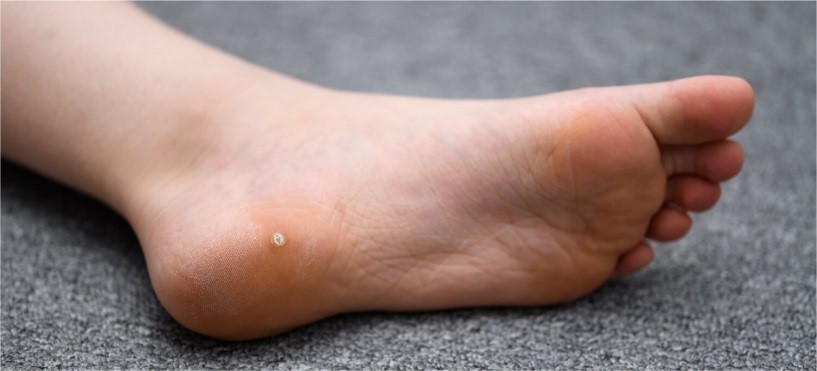
Warts on the feet can appear at any age. It happens that they go away on their own, but more often they cause great inconvenience, up to the inability to walk due to severe pain.
If you have a sedentary job, you can adapt somehow. However, for people leading an active lifestyle, who regularly play sports, the plantar wart becomes a hell of a torment.
Attempts to independently remove the plantar warts often end in nothing, since they grow from the deeper layers of the skin. The modern hardware methods, practiced in the clinic of aesthetic medicine and dermatology Esteva Clinic, come to the rescue.
Experienced doctors will select a safe and gentle way to get rid of this scourge, and you will soon be able to return to your favorite activities, be it dancing, morning jogging or conquering the peaks.
What do plantar warts look like?
Plantar warts are often confused with calluses. They are similar, both neoplasms look like a dense dry growth, sometimes painful. A callus hurts when pressed directly, a barb when pressed from the side.
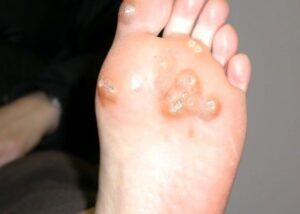
If you remove the upper stratum corneum, numerous black dots will be visible on the cut. These are capillaries (petechiae) through which the wart receives nutrition. Corns are completely dead tissue, there are no blood vessels in them.
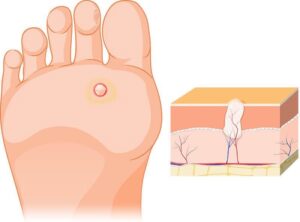
At the initial stage, the wart on the foot looks like a round spot with a depressed center. The surface is rough, becomes hard over time, resembling a cauliflower inflorescence.
With the formation of multiple papules in one area, they speak of a mosaic cluster. It forms predominantly on the cushion and causes severe pain when walking.
How warts on the leg look can be seen in the illustrations. Note that it is not worthwhile to carry out diagnostics based on the picture. Not a single photo can replace the consultation of a qualified dermatologist, who will not only make the correct diagnosis, but also select a method of treatment.
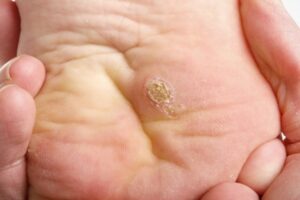
Causes of the appearance of warts and papillomas on the foot
A wart on the heel is an infectious disease caused by the human papillomavirus. There are about a hundred types of papillomavirus with different manifestations. Lesions on the skin of the legs are caused by types 1, 2, 4, 60 and 63.
Like other diseases of a viral nature, it occurs against the background of reduced or not formed immunity. For this reason, it is often found in adolescent children (12-16 years old), people after chemotherapy, organ transplantation (during treatment, such people receive immunosuppressants), with HIV.
The papilloma on the foot in adolescents can disappear without any intervention, simply due to the development of their own immunity. But the problem cannot be ignored, since the disease tends to spread quickly. At a minimum, enhanced preventive measures should be taken to keep family members or others safe.
What factors contribute to infection
Common areas in which sufficient hygiene measures are not maintained are factors in the spread of papillomavirus infection.
You can get infected and get a viral plantar warts:
- in the pool;
- in sauna;
- in the locker room at the sports club.
The fact is that the virus can remain outside the carrier for a long time. He has enough humid environment to maintain the ability to reproduce. Therefore, drops near the pool or in the changing room become the focus of infection.
In common areas, it is necessary to regularly and thoroughly disinfect. Visitors should use personal shoes (slippers), personal towels, and treat their feet with prophylactic agents after visiting.
Increased sweating of the feet, often characteristic of adolescents due to hormonal imbalance, contributes to the infection. Hygienic methods of combating sweating should be used more often in order not only to maintain external decency, but also to reduce the risk of infection.
How does infection occur?
The papillomavirus (HPV) enters the body through damaged skin. This is not necessarily an open wound, microcracks or abrasions are enough. With a strong immune response, the disease is suppressed in the embryo, and in immunocompromised individuals it can develop before visible growths appear.
Due to the fact that it takes some time from infection to manifestation, it is almost impossible to establish the source of the virus or the place of infection. Moreover, at the initial stages, the plantar warts may not manifest itself in any way. Soreness appears later and depends on the location. The most tangible places: the pads of the feet and the heel. Shoes that are too tight can aggravate the discomfort.
If there is no pain, the papilloma on the foot can not be touched, it heals itself; but at the same time it is imperative to adhere to the rules of personal hygiene.
Why are plantar warts dangerous?
Treatment of papilloma on the foot is necessary if the neoplasm causes pain, interferes with walking, grows, changes its appearance. Squamous cell carcinoma is sometimes mimicked as an unassuming tumor. The sooner this is discovered, the more successful the treatment will be.
The main danger to others is to get infected through direct contact with a sick person. Therefore, one should not change shoes, even within the family, and even more so in educational teams.
Use only personal socks or tights, do not let others take your things and shoes. These are the minimum conditions for the non-spread of infection.
What symptoms should be the reason for going to the doctor
The question “how to treat plantar warts” is often asked in our clinic and on specialized forums on the Internet.
We recommend starting with a visit to your doctor and a diagnosis. The fact is that the wart on the foot must be differentiated from other diseases that have similar manifestations, namely:
- lichen planus;
- seborrheic keratosis;
- fibroma;
- cutaneous horn;
- squamous cell carcinoma.
- basalioma
- molluscum contagiosum
- epidermal verrucous nevus
- corn
- palmar-plantar syphilis
To exclude the above diseases, you need to make an appointment with a dermatologist. During the examination, samples (scrapings) for biopsy may be taken.
After diagnosis, the specialist may prescribe one or more types of procedures.
How to get rid of a wart on your foot
In a clinic, the removal of a plantar warts is performed by more radical means. Some of the most successful methods include:
✔️ removal of a plantar warts with liquid nitrogen;
✔️ radio wave removal;
✔️ laser cauterization.
Laser removal of a plantar warts, as well as exposure to radio waves, destroys the structure of the neoplasm, at the same time clogging up the blood vessels. The procedures are carried out with anesthesia and give a visible result rather quickly.
Cryotherapy is equally effective in freezing unhealthy tissue.
Each of the methods is well tolerated and promotes rapid healing without scarring.
Old, large corns will require a second course, since large cornification is not removed in one session. Otherwise, this would lead to the formation of a deep scar and the inability to walk all the time while the regeneration process is taking place.
In a sparing mode, patients can lead a normal life within a day or two after cryodestruction or laser.
Your doctor may prescribe immunomodulatory therapy to combat HPV.
Each of the drugs described has its own regimen and should only be used as directed by a dermatologist.
Prevention of the appearance of wart on the foot
People with reduced immunity may experience relapses of the disease, not necessarily in the same place. At the same time, common warts do not tend to malignant transformation.
For the purpose of prevention, simple rules should be followed:
Do not walk barefoot in public places (showers, changing rooms, etc.).
Use only personal shoes, towels and linen.
Treat cuts, cracks in the skin with an antiseptic.
Observe general foot hygiene.
You can use prophylactic creams with essential oils or other disinfecting ingredients.
If neoplasms are found, visit a dermatologist.
Monitor the general state of health, immunity.
If the neoplasm hurts, interferes with the usual way of life, it must be removed. For this, either external medicines or destructive hardware methods are used – laser, cryodestruction. Only a qualified specialist should select a method of treatment after an appropriate diagnosis.
Benefits of treating warts on the stap at Esteva Clinic
📌 Esteva Clinic employs specialists with many years of experience who love their work
📌 We have dermatoscopy and histological examination available
📌 Esteva Clinic – the clinic of dermatology and aesthetic medicine has modern equipment for the treatment of warts and papillomas of the feet
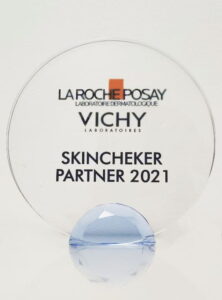
Esteva Clinic is the official partner of Skin Checker (La Roche-Posay company), which is a social project in the fight against skin neoplasms
Стоимость процедуры
Удаление папиллом и бородавок
| Название процедуры | Цена, грн |
|---|---|
| Консультация дерматолога обязательна | 790 |
| Контроль после удаления с 30 по 45 день после удаления | Бесплатно |
| Удаление папилломы / бородавки 1шт (до 0,5 см) | 490 |
| Удаление папилломы / бородавки 1шт (0,5 - 1 см) | 590 |
| Удаление папилломы / бородавки 1шт (1 - 2 см) | 990 |
| Пакет №1 (до 20 новообразований) | 2900 |
| Пакет №2 (до 30 новообразований) | 3900 |
| Пакет №3 (до 50 новообразований) | 4900 |
| Удаление новообразований в зоне вокруг глаз | 850 |
| Удаление новообразований в зоне вокруг глаз до 10 новообразований | 4900 |







